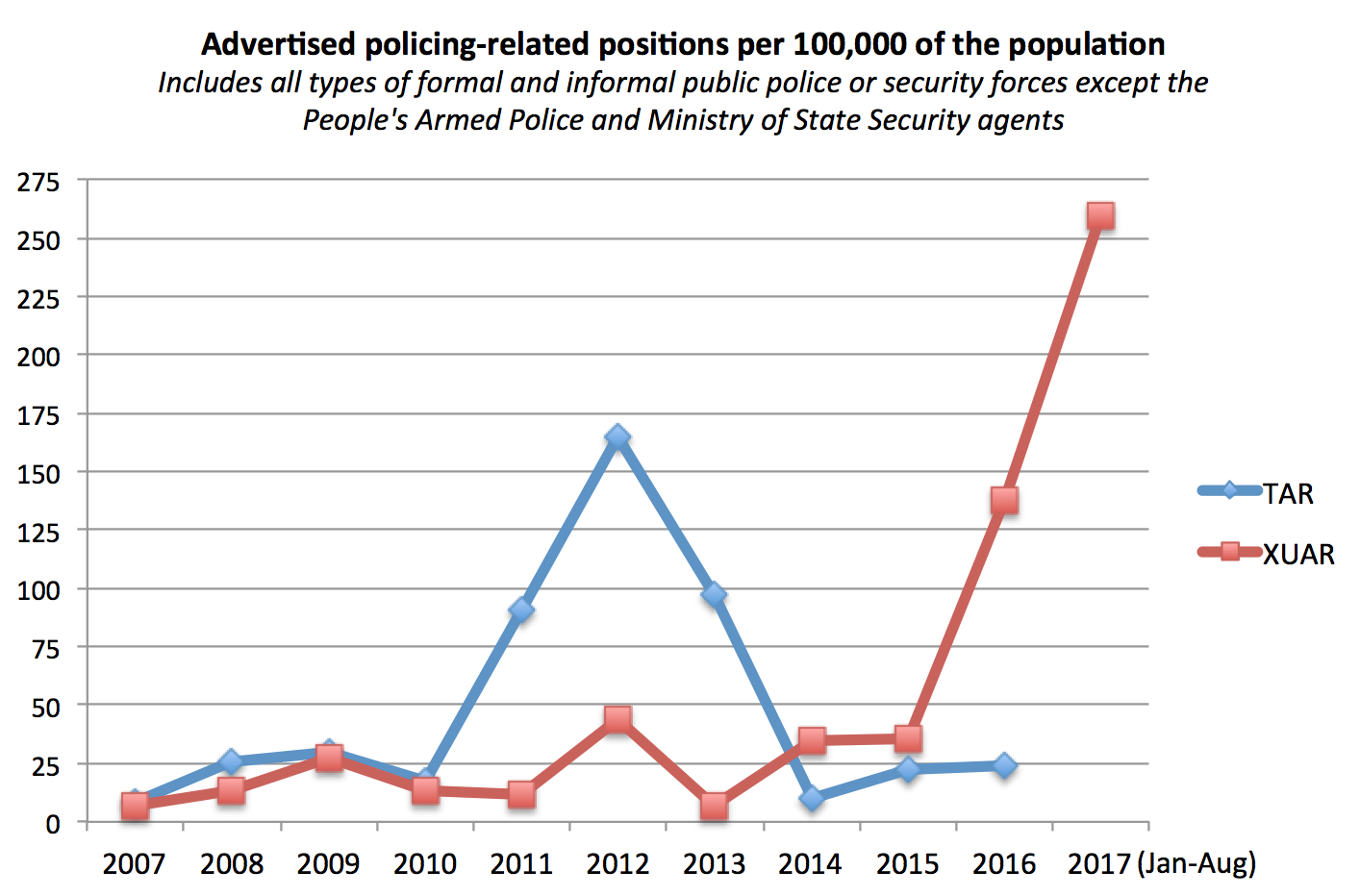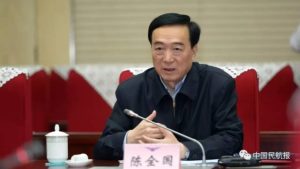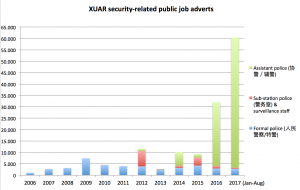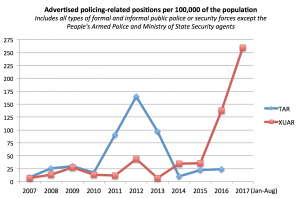Chen Quanguo: The Strongman Behind Beijing’s Securitization Strategy in Tibet and Xinjiang

China Brief, 21 September 2017

By Adrian Zenz & James Leibold – Over the last year, Chen Quanguo (陈全国) has dramatically increased the police presence in Xinjiang by advertising over 90,000 new police and security-related positions. [1] This soldier-turned-politician is little known outside of China, but within China he has gained a reputation as an ethnic policy innovator, pioneering a range of new methods for securing Chinese Communist Party (CCP) rule over Uyghurs, Tibetans and other ethnic minorities in western China.
Born into a poor family in rural Henan province, Chen worked his way up the CCP ladder, serving first under Premier Li Keqiang in his native Henan, before becoming Party Secretary of neighboring Hebei province. In 2011, he was handed the difficult task of ruling the Tibetan Autonomous Region (TAR), which had once again erupted into violence in 2008. During his five years in Tibet, he restored stability through the construction a sophisticated network of surveillance and control. After being transferred to the Xinjiang Uyghur Autonomous Region (XUAR) in August 2016, he quickly rolled out the same securitization strategy, accomplishing in a single year what took him five years in the TAR.
In Tibet and now Xinjiang, Chen Quanguo lifted a strategy directly from the imperial playbook, with past colonial powers like England and Japan enlisting ”native” populations to watch over their own people. Ethnic minorities have long served the CCP in China. However, the numbers of Uyghurs and Tibetans that have been recruited into China’s security apparatus under Chen far exceed public recruitments during the preceding decade and are potentially setting a historic record.
Chen Quanguo’s Policing Strategy in Tibet
Within two months of assuming power in Tibet Autonomous Region (TAR) in August 2011, Chen Quanguo rolled out his first and perhaps most effective security innovation, the so-called convenience police stations (便民警务站), street-corner bulwarks for community-based policing. In October 2011, the TAR advertised 2,500 police positions, with 458 of them designated for Lhasa’s new convenience police stations (Xueyu jiaoyu, October 21, 2011). By August 2012, Lhasa had established 161 of these concrete structures with a distance of no more than 500 meters between stations (Ministry of Public Security, August 12, 2012).
This dense network of surveillance is at the heart of what Party officials call “grid-style social management” (社会网格化管理), a practice that segments urban communities into geometric zones so that security staff can systematically observe all activities with the aid of new technologies (ChinaChange, August 8, 2013; China Brief, August 17). The system relies on big data analytics, connecting a network of CCTV cameras with police databases to achieve enhanced, even automated surveillance. Grid management was first trialed in Beijing in 2004 (Chinese Academy of Social Sciences, October 28, 2013). Chen’s implementation of the convenience police station network in China’s West is probably the most sophisticated implementation yet.
By 2016, the TAR had established over 700 of these stations throughout all urban and semi-urban centers (News.163.com, March 4, 2016). In order to man them, regional authorities dramatically increased security recruitment. Between 2007 and the summer of 2011, the TAR advertised 2,830 positions for all types of police officers. Between 2008–2009, annual police recruitment averaged 866 positions, already a steep increase over the 260 positions advertised in 2007 before the Lhasa riots. However, after Chen Quanguo assumed office, recruitment skyrocketed. Between the autumn of 2011 and 2016, the TAR advertised 12,313 policing-related positions—over four times as many positions as the preceding five years.
Chen Quanguo Applies His Security Strategy to Xinjiang
During Chen Quanguo’s five-year rule in Tibet, this previously restive minority region experienced no major incidents of unrest. Only eight of the 150 self-immolation incidents (a form of protest) occurred in the TAR, with no self-immolations or other incidents of major social unrest reported in the region after 2012 (International Campaign for Tibet, [accessed August 30]). Chen’s performance was praised in the Chinese language media, with one report noting that “TAR society maintained stability, with no major reported incidents of unrest, whereas [such incidents] did occur in the surrounding Tibetan regions” (Phoenix Information, August 29, 2016).
Chen’s firm grip on stability in Tibet did not go unnoticed in Beijing. While there was talk of replacing former XUAR Party Secretary Zhang Chunxian with a close ally of Xi Jinping, Chen Quanguo emerged as a capable and politically reliable candidate in 2016 (Aboluowang, April 18, 2014). By proving himself with a difficult ethnic portfolio and being one of the first senior Party officials to speak of Xi Jinping as “core” of the Party leadership, Chen gained Xi’s confidence (Wenxuecheng, August 31, 2016). He will likely be rewarded with a seat on the Politburo at the 19th Party Congress.
At the time of Chen’s new appointment, Xinjiang represented a far greater security concern for Beijing than the TAR. Under his predecessors, Xinjiang had already considerably ramped up the recruitment of police and other security officers in response to the 5 July 2009 riots in Urumqi. Between 2003–2008, Xinjiang advertised about 5,800 such positions, yet these intakes multiplied to nearly 40,000 between 2009 and July 2016. On average, police adverts increased from just below 1,000 to nearly 5,000 positions per year. As described in more detail in our previous article, this recruitment drive relied increasingly on contract-based positions outside the formal civil service system (China Brief, March 14). This strategy enabled a cost-efficient expansion of the police force. It leveraged the limited manpower of formal and better-equipped regular police (人民警察) and special police units (特警) through the establishment of a new underclass of poorly-trained and (traditionally) lower-paid assistant police (协警 or 辅警).
Between August 2016 and July 2017, Chen Quanguo pushed this multi-tiered policing system to its logical conclusion. Within the space of a single year, Xinjiang advertised 90,866 security-related positions—nearly twelve times the number advertised in 2009 following the Urumqi riots. The vast majority of these jobs (95 percent) were assistant police positions associated with the establishment of an estimated 7,500 convenience police stations across Xinjiang (Energy News, January 12). [2] Depending on their size, convenience police stations have a staffing quota of six to thirty security personnel, while current advertised recruitments stand at around 12 assistant police per station. This suggests that Chen’s recruitment drive will likely continue into next year (Zhongguo xiaofang Zaixian, January 16, 2017; Zhonggong jiaoyu, May 9). [3]

Figure 1. Source: XUAR civil service, public service, and other public job announcements.
“Surveillance” pertains to various positions related to internet and video surveillance systems. Formal police positions also include security-related civil service positions in the court, justice and prison systems.
Comparing Chen’s Security Buildup in Xinjiang and Tibet
How do these astonishing figures in Xinjiang compare to the TAR? The larger recruitment and police station figures for Xinjiang are not surprising, considering that the XUAR’s population in 2015 stood at 23.2 million, more than seven times the TAR’s 3.2 million.
Xinjiang is also Beijing’s top domestic security concern at present. First, Uyghur resistance and fear of ”Islamic extremism” are now viewed as a far greater threat to CCP rule than Tibetan unrest. Second, stability in Xinjiang is crucial to the success of Xi Jinping’s signature One Belt, One Road (一带一路) initiative, with Xinjiang reemerging as a “core region” (核心区) and strategic crossroad for trade and investment opportunities in Central and South Asia, as well as Europe and the Middle East (Xinhua, June 4, 2015).
When comparing figures for the two regions per capita, the available data indicates that the XUAR might now have considerably more convenience police stations per capita than the TAR: 323 versus the TAR’s 216 per 100,000 of the population. On the other hand, the TAR advertised 400 policing-related positions per 100,000 of its population during Chen Quanguo’s rule there, while Xinjiang advertised 394 such positions. [4] Yet the security build-up in Xinjiang is continuing, and likely to surpass the level achieved in the TAR as early as September this year. That said, the sheer number of positions advertised in the XUAR during such a short period of time is apparently making it increasingly difficult to attract new applicants. [5]
Unrest in Tibetan regions has been much more sporadic since 2008, with most acts being limited to self-harm. Uyghur militants, on the other hand, have carried out a string of deadly attacks on local police stations and other public settings that have resulted in thousands of deaths since 2009. Most notably, a series of high-profile terror attacks outside the XUAR, including a suicide car bombing in Beijing (October 2013) and the train station stabbing in Kunming (March 2014) seriously unnerved the Chinese populace and prompted the central government to take an even tougher stance.
After the April 2014 Urumqi market bombing, which left 43 dead and over 90 injured, Xi Jinping announced a nationwide counter-terrorism campaign. Xinjiang party secretary Zhang Chunxian called for a “people’s war on terror”, while Xi spoke of the need to build “walls made of copper and steel” (People’s Daily, May 26, 2014; Xinhua, May 29, 2014). The concurring rise of Xi’s Belt and Road Initiative, whose land route relies on Xinjiang as the primary traffic hub, further elevated the importance of the region’s security.
In response, advertised police recruitments in 2014 and 2015 increased rapidly in Xinjiang. They significantly exceeded the per capita count of the 2009 intake following the Urumqi riots, being three to four times as high as in 2007-08, 2010-11 or 2013. However, as Figure 2 reveals, this build up for Zhang’s ‘war on terror’ was actually quite minor when compared to the massive increase in advertised policing positions under Chen Quanguo (2016/17).

Figure 2. Population figures are from 2012 (sources: TAR/XUAR Statistical Yearbooks).
On the surface, Chen Quanguo’s strategy seems to be producing results. As in Tibet, there have been no major incidents of ethnic unrest or violence since the establishment of the convenience police stations, with the last major incident occurring in September 2015 when a stabbing at a coal mine in southern Xinjiang left 50 dead. Since then, there have only been comparatively minor and apparently unpremeditated knife attacks. In fact, the XUAR’s new network of convenience police stations were praised for the quick response to a stabbing in Pishan County in February 2017, despite the fact that five innocent bystanders were killed before armed police shot dead three assailants (Sina, February 22). While limits on reporting from the region preclude any reliable statistical accounts of incidents in Xinjiang, it seems less-than-likely that any major incident would go completely unnoticed.
Securitization as Employment Strategy
Chen Quanguo’s securitization strategy achieves two stability maintenance (维稳) goals at the same time: the construction of a dense network of police surveillance, and a range of new employment opportunities in a region where stable, well-remunerated jobs are still relatively scarce. Our analyses of recruitment documents indicate that Tibetans have benefited significantly from Chen’s job bonanza. Based on the available data, we estimate that between 2012 and 2016 about 77 percent of applicants who either obtained or were close to obtaining a government job were Tibetan. [8] While this share is lower than the overall Tibetan population share of 90.5 percent, it exceeds the share of Tibetans among all TAR university graduates (only tertiary graduates are eligible to apply for formal government jobs). [9]
Even though Chen has not replicated the full employment promise in Xinjiang, security-related work is now the single most important source of new jobs. Growth in “urban non-private units,” a technical term that refers to stable, well-remunerated posts in a) public institutions and b) larger private corporations, slowed down considerably in 2014 and 2015 compared to previous years. [10] Excluding employment in public institutions, Xinjiang’s private corporate sector by itself virtually stagnated during that period. Key sectors such as manufacturing, mining, construction, and transportation actually saw a reduction in employment. This is likely a negative side effect of the region’s exorbitant new security measures. A local businessman told us that Chen’s security measures have resulted in numerous businesses going bankrupt, even in the wealthier north. As a consequence, investors are said to be withdrawing their capital, and qualified employees are leaving the region. Official data reflects this trend. In 2016, XUAR fixed-asset investment from private investors fell by 22 percent or nearly 100 billion RMB, a sharp reversal compared to several years of double-digit growth. After years of double-digit growth that trumped the national average, Xinjiang’s per capita GDP declined by 1.4 percent in 2015 and only grew by a tiny 1 percent in 2016, now far below the national figures. [11]
In this precarious situation, Chen’s security recruitment drive is more than compensating for the employment trough in other sectors. Between 2014 and 2015, Xinjiang’s entire private corporate employment sector added only 38,000 jobs. [12] This is less than half the nearly 91,000 security-related positions advertised during Chen’s first year in Xinjiang. While lower-tier security jobs typically pay much lower salaries than corporate private sector work, their pay levels are increasing significantly in Xinjiang. In 2017, they averaged around 4,700 RMB/month, only 13 percent below the region’s average public institutional and corporate private sector wage level of 5,386 RMB/month (2016). These assistant police jobs now pay substantially more than the average non-corporate private sector wage of 3,133 RMB/month for Xinjiang and 3,300 RMB/month for China (both 2015). [13] Furthermore, they now come with a standard set of social benefits, the so-called “five insurances” (五险) of age, medical, unemployment, injury and maternity insurance. And in the current political environment, these contract-based positions are likely very secure. In 2017, 27 percent of them even offered salaries and benefits commensurate with formal government employment, with others permitting recruits to apply for entry into the formal police service after two or three years.
As in the TAR, Xinjiang’s ethnic minorities (including Uyghurs) have been able to secure a large proportion of these new security positions. Whereas formal government (or corporate private sector) employment mandates that applicants must hold a university degree, assistant police positions usually require only a middle or high school education. For the large number of lesser-educated and socially disadvantaged rural minorities, especially the Uyghurs, an informal policing job that pays 3,000-6,000 RMB per month is an attractive offer, especially when it comes with a level of social status and authority. At the same time, this marginalized population is precisely the one that poses the greatest security risk. Chen’s strategy of paying generous salaries to thousands of impoverished Uyghurs to get them to monitor their own people, therefore, kills two birds with the same stone. [14]
Conclusion: Will Chen Quanguo’s Securitization Approach be Successful?
Despite its short-term successes, Chen Quanguo’s policing strategy bears at least three major risks:
The first risk is economic. The intense securitization of Xinjiang society has placed major burdens on its economy. Chen introduced measures that severely restrict the free flow of labor. Uyghurs across Xinjiang are being forced to return to their home regions, typically rural areas with very few viable sources of employment. In Urumqi, itinerant Uyghur shops and businesses are systematically being shut down. In southern Xinjiang, people cannot even visit a relative in a nearby village without obtaining a written permit. Mushrooming numbers of checkpoints have nearly doubled travel times, increasing the cost of doing business. Businesses are additionally burdened by heavy security requirements, such as installing metal detectors or even airport-style X-ray scanners at entrances, procuring monitoring equipment, alarms, riot-proof doors, or having to hire private security guards. Meanwhile, the state’s massive top-down investments, facilitated through the “pairing assistance” (援疆) program, likewise lack customers, both stemming from intense security measures and a failure to cater for what people actually need (South China Morning Post, September 4). [15]
The second risk is that heavy-handed securitization exacerbates ethnic tensions. Despite the absence of major incidents, hatred and resentment continues to simmer below the surface. Extreme measures such as restricting the sale of sugar per household to prevent bomb making or placing traceable serial numbers on knives and sharp metal tools cannot possibly replace a genuine long-term solution for sustainable ethnic relations. Inter-ethnic trust and cohesion are in short supply in Xinjiang.
The third, and most easily overlooked risk is the alienation of the local Han population. Those we interviewed claim that Chen Quanguo is disliked—even hated—by both the Han and Uyghur population. A third-generation ethnic Han interviewee from northern Xinjiang stated that even Han from more developed regions with fewer Uyghurs are so deeply affected by the omnipresent security measures that they are desperate to leave, with many seeking to move their residence status to another province, or even emigrate overseas. In fact, XUAR residential property investment declined sharply in 2016, especially in the Han-dominated cities of Urumqi and Karamay, where it fell by 15 and 22 percent respectively. [16] Another source cited a Han friend as saying: “With Chen, the Uyghurs at last have a hero, because he is driving the Han away [from Xinjiang].”
Chen Quanguo may have succeeded in squashing Uyghur resistance for now, but the human and economist costs might prove unsustainable in the long run.
Written by Adrian Zenz and James Leibold inChina Brief, Volume: 17 Issue: 12

